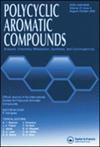合成 3-氨基-5-甲基异噁唑席夫碱及其生物活性评估的另一种绿色方法
IF 2.6
3区 化学
Q2 CHEMISTRY, ORGANIC
引用次数: 0
摘要
异恶唑席夫碱在药物化学、药学、配位化学、工业化学等领域发挥着重要作用,因此,寻找更容易、更可靠的合成方法仍在进行中。本文研究了3-氨基-5-甲基异恶唑与多种芳香族醛的一步缩合反应,在短时间内获得了收率高的异恶唑希夫碱支架(包括一种新化合物)。该过程是一个无溶剂的条件下使用DMEA作为绿色催化剂。对产品对革兰氏阳性菌和革兰氏阴性菌(包括金黄色葡萄球菌、表皮葡萄球菌、铜绿假单胞菌和骨沙门氏菌)的抑菌效果进行了评价。以抗坏血酸和槲皮素为标准,测定了产品的抗氧化活性。所产生的席夫碱具有清除DPPH自由基的能力。这意味着这些产品可以用作抗氧化剂。两种合成的化合物通过细胞毒性测试对其抗癌活性进行了评估,结果表明,细胞系对人乳腺癌细胞系和胃腺癌细胞系的毒性逐渐减弱。因此,该产品可作为抗癌剂使用。本文章由计算机程序翻译,如有差异,请以英文原文为准。
An Alternative Green Method for Synthesis of 3-Amino-5-Methylisoxazole Schiff Bases and Their Bioactivity Evaluation
Isoxazole Schiff bases play an important role in medicinal chemistry, pharmacy, coordination chemistry, and industrial chemistry, therefore, finding easier and more reliable procedures for their synthesis is still in process. The present work deals with a single-step condensation reaction between 3-amino-5-methylisoxazole and various aromatic aldehydes to furnish a Schiff base scaffold of isoxazole (including one new compound) with excellent yields in a short time. The procedure is a solvent-free condition using DMEA as a green catalyst. The products were evaluated for their antibacterial efficacy against gram-positive and gram-negative bacteria including Staphylococcus aureus, Staphylococcus epidermidis, Pseudomonas aeruginosa, and Salmonella abony. The antioxidant activity of the products was tested and the ascorbic acid and quercetin were used as standards. The produced Schiff bases exhibited the ability to scavenge the free radicals from the DPPH. This means that the products can be used as antioxidants. Two of the synthesized compounds were evaluated for their anticancer activity by testing their cytotoxic potency, which showed diminishing toxicity of cell lines against human breast cancer cell lines and gastric adenocarcinoma cell lines. Therefore, the products can be utilized as anticancer agents.
求助全文
通过发布文献求助,成功后即可免费获取论文全文。
去求助
来源期刊

Polycyclic Aromatic Compounds
化学-有机化学
CiteScore
3.70
自引率
20.80%
发文量
412
审稿时长
3 months
期刊介绍:
The purpose of Polycyclic Aromatic Compounds is to provide an international and interdisciplinary forum for all aspects of research related to polycyclic aromatic compounds (PAC). Topics range from fundamental research in chemistry (including synthetic and theoretical chemistry) and physics (including astrophysics), as well as thermodynamics, spectroscopy, analytical methods, and biology to applied studies in environmental science, biochemistry, toxicology, and industry. Polycyclic Aromatic Compounds has an outstanding Editorial Board and offers a rapid and efficient peer review process, as well as a flexible open access policy.
 求助内容:
求助内容: 应助结果提醒方式:
应助结果提醒方式:


